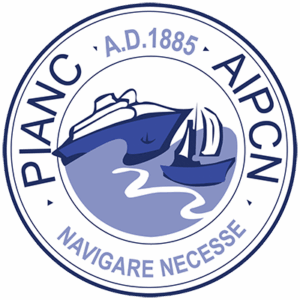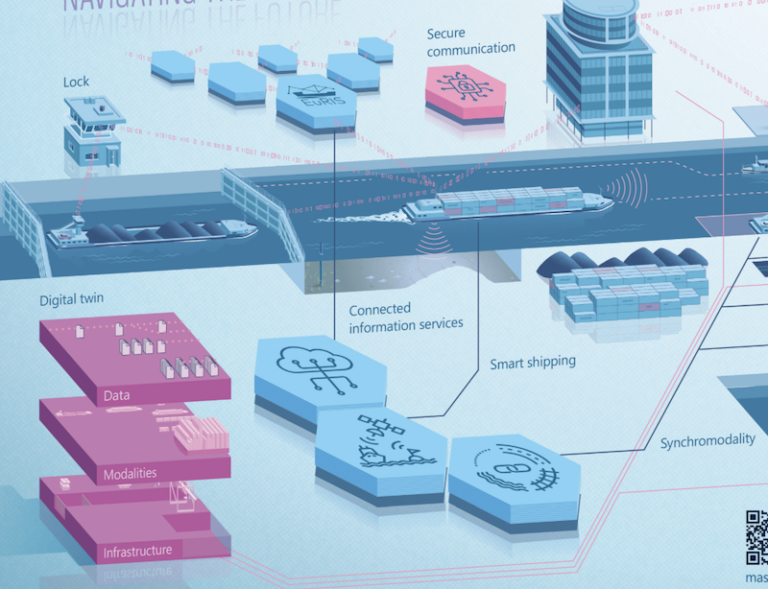Image used from DIWA Copyright 2025 https://www.masterplandiwa.eu
New PIANC InCom WG257 Digital Twins for Operation and Monitoring of Inland Waterways and Infrastructure – call out for members.
Considering the complexities of Inland Waterways and its infrastructure, operating and monitoring hydraulic navigation structures presents significant challenges, particularly when managing and analyzing the vast quantities of data (“big data”) these systems generate.
A Digital Twin model is a digital replica of a real object (such as a structure) or process (such as river flow) or system (interaction between river flow and structure). Digital twin technologies, often powered by machine learning algorithms, offer promising solutions to these challenges.
To effectively implement digital twins in inland waterway management, several challenges must be addressed:
• To establish an universal definition for digital twins of hydraulic and navigation structures.
• Identify existing applications to establish foundational knowledge and best practices, while developing interoperability standards which will enhance integration capabilities for operating and monitoring inland waterways and their infrastructure.
Objectives of WG257
• Develop a common definition for Digital Twins of hydraulic and navigation structures that includes specific maturity levels.
• Develop a definition of maturity levels, which can help to effectively communicate goals, expectations and limitations more reliably.
• Consolidate initial experiences and feedback’s from digital twin applications in hydraulic and navigation structures through case studies.
• Identify potential new applications of digital twins to facilitate or improve the operation and monitoring of hydraulic navigation structures.
• Establish baseline standards for digital twin interoperability, especially where digital twins are applied for construction and monitoring of physical structures.
For more information please download both the WG257 Terms of Reference and the Case Studies Annex.
Interested in being part of this International Working Group?
If you would like to represent the Australian & New Zealand National Section of PIANC on this Working Group, please apply to the AU-NZ Board. Many of our members are currently active on a number of PIANC Working Groups and they produce significant outcomes that benefit maritime matters in our region. They also bring significant benefits to participants who get to meet, learn from and share with global experts.
Please advise if you qualify as a Young Professional (YP – 40 years or younger) as there are two positions available in each Working Group, one of which is for a YP.
How to Apply
Please forward your application before COB Wednesday 30 April 2025 to:
Apply to Greg Britton, (Technical Commission Lead AU-NZ) E: greg.britton@rhdhv.com, and Paul Weston, EO E: Paul.weston@pianc.org.au
Process for Applications
Your application should include a detailed CV/Resume with a short covering letter outlining:
1. Your experience in the particular technical field;
2. Why the WG is relevant for the Australian / NZ content and the direct benefits of participation;
3. A commitment that you will prepare (for distribution to all members) a short report providing an overview & outcomes of the WG etc;
4. Whether or not you are seeking to access Travel Assistance Policy (TAP )funding; and
5. Whether you qualify as a Young Professional.
Eligibility:
Please note that Working Group Members need to be Individual Members of PIANC, working for a Corporate Member or Platinum Partner, be an invited expert or a be a member of a Sister Organisation.
Process:
A Selection Committee will review all nominations received and make a final recommendation to the PIANC AU-NZ Chair.
Responsibilities:
Please be aware that membership of a Working Group requires your active participation. This includes attending typically four Working Group meetings per year – most held virtually but typically at least one in-person meeting once a year at an international location (generally Europe). You may apply to be a ‘Corresponding Member’ if you do not want to undertake the normal travel requirements of full membership. If you are expert in the field, however, and would like to influence the outcome of the Working Group we encourage you to participate as fully as you are able.
Costs:
All costs associated with membership must be borne by either yourself or your employer, however PIANC Australia & New Zealand has a Travel Assistance Policy to partially assist with travel & attendance at Working Group meetings, in order to promote Australian and New Zealand technical input into these important WG activities.
Under the PIANC AU-NZ Travel Assistance Policy (TAP), annual available funding per WG member is $3,000, subject to application and approval. TAP funds may be payable post travel upon the successful completion of a WG Summary Report and production of relevant travel receipts.

